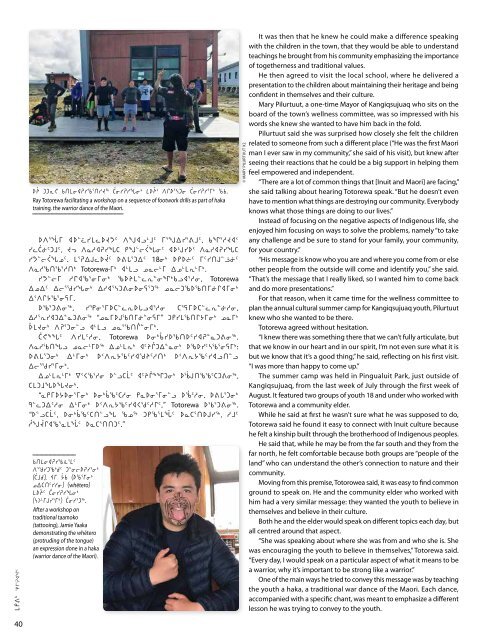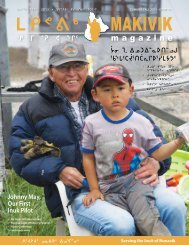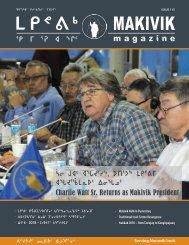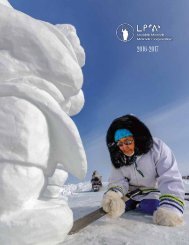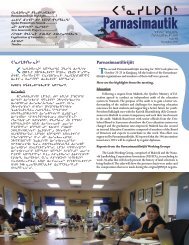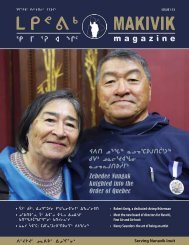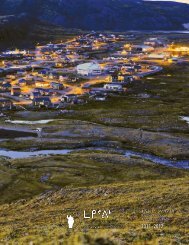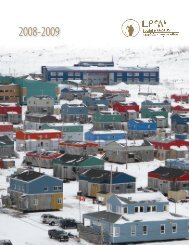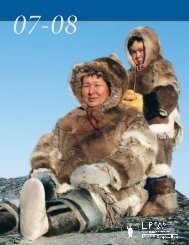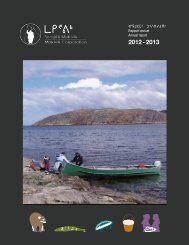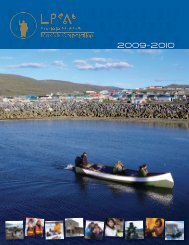Makivik Magazine Issue 114
You also want an ePaper? Increase the reach of your titles
YUMPU automatically turns print PDFs into web optimized ePapers that Google loves.
ᒪᑭᕕᒃ ᕿᒥᕐᕈᐊᖏᑦ<br />
ᐅᔩ ᑐᑐᕆᕙ ᑲᑎᒪᓂᐊᕈᓯᖃᕐᑎᓯᔪᖅ ᑖᓂᓯᕈᓯᖓᓂᒃ ᒪᐅᔩᑦ ᐱᒋᐅᕐᓴᑐᓂ ᑖᓂᓯᕈᓯᕐᒥᒃ ᖃᑲ.<br />
Ray Totorewa facilitating a workshop on a sequence of footwork drills as part of haka<br />
training, the warrior dance of the Maori.<br />
ᐅᐱᕐᖔᒥ ᐊᐅᓪᓛᓯᒪᓚᐅᔪᕗᑦ ᐱᖑᐊᓗᒻᒧᑦ ᒥᕐᖑᐃᓯᕐᕕᒧᑦ, ᑲᖏᕐᓱᔪᐊᑉ<br />
ᓯᓚᑖᓃᑦᑐᒧᑦ, ᔪᓓ ᐱᓇᓱᐊᕈᓯᖓᑕ ᑭᖑᓪᓕᐹᖓᓂᑦ ᐊᐅᒡᒍᓯᐅᑉ ᐱᓇᓱᐊᕈᓯᖓᑕ<br />
ᓯᕗᓪᓕᐹᖓᓄᑦ. ᒪᕐᕈᐃᒍᓚᐅᔫᑦ ᐅᕕᒐᕐᑐᐃᑦ 18ᓂᒃ ᐅᑭᐅᓖᑦ ᒥᑦᓯᑎᒍᓪᓘᓃᑦ<br />
ᐱᓇᓱᖃᑎᖃᕐᓱᑎᒃ Totorewa-ᒥᒃ ᐊᒻᒪᓗ ᓄᓇᓕᒻᒥ ᐃᓄᒻᒪᕆᒻᒥᒃ.<br />
ᓯᕗᓪᓕᒥ ᓱᒋᐊᖃᕐᓂᒥᓂᒃ ᖃᐅᔨᒪᓪᓚᕆᓐᓂᖏᒃᑲᓗᐊᕐᓱᓂ, Totorewa<br />
ᐃᓄᐃᑦ ᐃᓕᕐᖁᓯᖓᓂᒃ ᐃᓱᐊᕐᓴᑐᕕᓂᐅᓂᕋᕐᑐᖅ ᓄᓇᓕᑐᖃᐅᖃᑎᒥᓃᒋᐊᒥᓂᒃ<br />
ᐃᑉᐱᒋᔭᖃᕐᓂᕋᒥ.<br />
ᐅᖃᕐᑐᕕᓂᖅ, ᓯᕿᓂᕐᒥᐅᑕᓪᓚᕆᐅᒐᓗᐊᕐᓱᓂ ᑕᕐᕋᒥᐅᑕᓪᓚᕆᓐᓃᓱᓂ,<br />
ᐃᓱᕐᕆᓯᐊᑐᐃᓐᓇᑐᕕᓂᖅ “ᓄᓇᒥᐅᒍᖃᑎᒥᓃᓐᓂᕋᒥ” ᑐᑭᓯᒪᖃᑎᒋᔭᒥᓂᒃ ᓄᓇᒥᒃ<br />
ᐆᒪᔪᓂᒃ ᐱᕈᕐᑐᓂᓪᓗ ᐊᒻᒪᓗ ᓄᓇᕐᖃᑎᒌᓐᓂᒥᒃ.<br />
ᑖᕙᖕᖓᑦ ᐱᓯᒪᑦᓱᓂ, Totorewa ᐅᓂᒃᑳᓯᐅᖃᑎᐅᑦᓯᐊᕈᓐᓇᑐᕕᓂᖅ.<br />
ᐱᓇᓱᖃᑎᖓᓗ ᓄᓇᓕᒻᒥᐅᖅ ᐃᓄᒻᒪᕆᒃ ᐊᑦᔨᒌᑐᐃᓐᓇᓂᒃ ᐅᖃᐅᓯᑦᓴᖃᕐᓂᕋᒥᒃ:<br />
ᐅᕕᒐᕐᑐᓂᒃ ᐃᒻᒥᓂᒃ ᐅᑉᐱᕆᔭᖃᑦᓯᐊᖁᔨᑦᓱᑎᒃ ᐅᑉᐱᕆᔭᖃᑦᓯᐊᓗᑎᓪᓗ<br />
ᐃᓕᕐᖁᓯᕐᒥᓂᒃ.<br />
ᐃᓄᒻᒪᕆᒻᒥᒃ ᐁᑉᐸᖃᕐᓱᓂ ᐅᓪᓗᑕᒫᑦ ᐊᑦᔨᒌᖕᖏᑐᓂᒃ ᐅᖄᒍᑎᖃᖃᑦᑕᑐᕕᓂᖅ,<br />
ᑕᒪᑐᒧᖓᐅᖓᔪᓂᒃ.<br />
“ᓇᑭᒥᐅᔭᐅᓂᕐᒥᓂᒃ ᐅᓂᒃᑳᖃᑦᑕᓱᓂ ᑭᓇᐅᓂᕐᒥᓂᓪᓗ ᐅᖄᑦᓱᓂ. ᐅᕕᒐᕐᑐᓂᒃ<br />
ᑫᓪᓚᑐᐃᑦᓱᓂ ᐃᒻᒥᓂᒃ ᐅᑉᐱᕆᔭᖃᑦᓯᐊᐸᖁᑦᓱᒋᑦ,” Totorewa ᐅᖃᕐᑐᕕᓂᖅ.<br />
“ᐅᓪᓗᑕᒫᑦ, ᐅᓂᒃᑳᖃᑦᑕᑎᓪᓗᖓ ᖃᓄᖅ ᑐᑭᖃᕐᒪᖔᑦ ᐅᓇᑕᕐᑎᐅᒍᓯᖅ, ᓱᒧᑦ<br />
ᓲᖑᔫᒋᐊᖃᕐᓇᒪᖔᑦ ᐅᓇᑕᕐᑎᑎᑐᑦ.”<br />
ᑲᑎᒪᓂᐊᕈᓯᖃᕇᕐᒪᑦ<br />
ᐱᕐᖁᓯᑐᖃᒃᑯᑦ ᑐᓐᓂᓕᐅᕈᓯᕐᓂᒃ<br />
(ᑖᒧᑯ), ᔦᒥ ᔮᑲ (ᐅᖃᕐᒥᓂᒃ<br />
ᓄᐃᑕᑎᑦᓯᓱᓂ) (whētero)<br />
ᒪᐅᔩᑦ ᑖᓂᓯᕈᓯᖓᓂᒃ<br />
(ᓴᐳᒻᒥᒍᓯᕐᒥᒃ) ᑖᓂᓯᕐᑐᖅ.<br />
After a workshop on<br />
traditional taamoko<br />
(tattooing), Jamie Yaaka<br />
demonstrating the whētero<br />
(protruding of the tongue)<br />
an expression done in a haka<br />
(warrior dance of the Maori).<br />
© MARY PILURTUUT X2<br />
It was then that he knew he could make a difference speaking<br />
with the children in the town, that they would be able to understand<br />
teachings he brought from his community emphasizing the importance<br />
of togetherness and traditional values.<br />
He then agreed to visit the local school, where he delivered a<br />
presentation to the children about maintaining their heritage and being<br />
confident in themselves and their culture.<br />
Mary Pilurtuut, a one-time Mayor of Kangiqsujuaq who sits on the<br />
board of the town’s wellness committee, was so impressed with his<br />
words she knew she wanted to have him back in the fold.<br />
Pilurtuut said she was surprised how closely she felt the children<br />
related to someone from such a different place (“He was the first Maori<br />
man I ever saw in my community,” she said of his visit), but knew after<br />
seeing their reactions that he could be a big support in helping them<br />
feel empowered and independent.<br />
“There are a lot of common things that [Inuit and Maori] are facing,”<br />
she said talking about hearing Totorewa speak. “But he doesn’t even<br />
have to mention what things are destroying our community. Everybody<br />
knows what those things are doing to our lives.”<br />
Instead of focusing on the negative aspects of Indigenous life, she<br />
enjoyed him focusing on ways to solve the problems, namely “to take<br />
any challenge and be sure to stand for your family, your community,<br />
for your country.”<br />
“His message is know who you are and where you come from or else<br />
other people from the outside will come and identify you,” she said.<br />
“That’s the message that I really liked, so I wanted him to come back<br />
and do more presentations.”<br />
For that reason, when it came time for the wellness committee to<br />
plan the annual cultural summer camp for Kangiqsujuaq youth, Pilurtuut<br />
knew who she wanted to be there.<br />
Totorewa agreed without hesitation.<br />
“I knew there was something there that we can’t fully articulate, but<br />
that we know in our heart and in our spirit, I’m not even sure what it is<br />
but we know that it’s a good thing,” he said, reflecting on his first visit.<br />
“I was more than happy to come up.”<br />
The summer camp was held in Pingualuit Park, just outside of<br />
Kangiqsujuaq, from the last week of July through the first week of<br />
August. It featured two groups of youth 18 and under who worked with<br />
Totorewa and a community elder.<br />
While he said at first he wasn’t sure what he was supposed to do,<br />
Totorewa said he found it easy to connect with Inuit culture because<br />
he felt a kinship built through the brotherhood of Indigenous peoples.<br />
He said that, while he may be from the far south and they from the<br />
far north, he felt comfortable because both groups are “people of the<br />
land” who can understand the other’s connection to nature and their<br />
community.<br />
Moving from this premise, Totorowea said, it was easy to find common<br />
ground to speak on. He and the community elder who worked with<br />
him had a very similar message: they wanted the youth to believe in<br />
themselves and believe in their culture.<br />
Both he and the elder would speak on different topics each day, but<br />
all centred around that aspect.<br />
“She was speaking about where she was from and who she is. She<br />
was encouraging the youth to believe in themselves,” Totorewa said.<br />
“Every day, I would speak on a particular aspect of what it means to be<br />
a warrior, why it’s important to be strong like a warrior.”<br />
One of the main ways he tried to convey this message was by teaching<br />
the youth a haka, a traditional war dance of the Maori. Each dance,<br />
accompanied with a specific chant, was meant to emphasize a different<br />
lesson he was trying to convey to the youth.<br />
40


